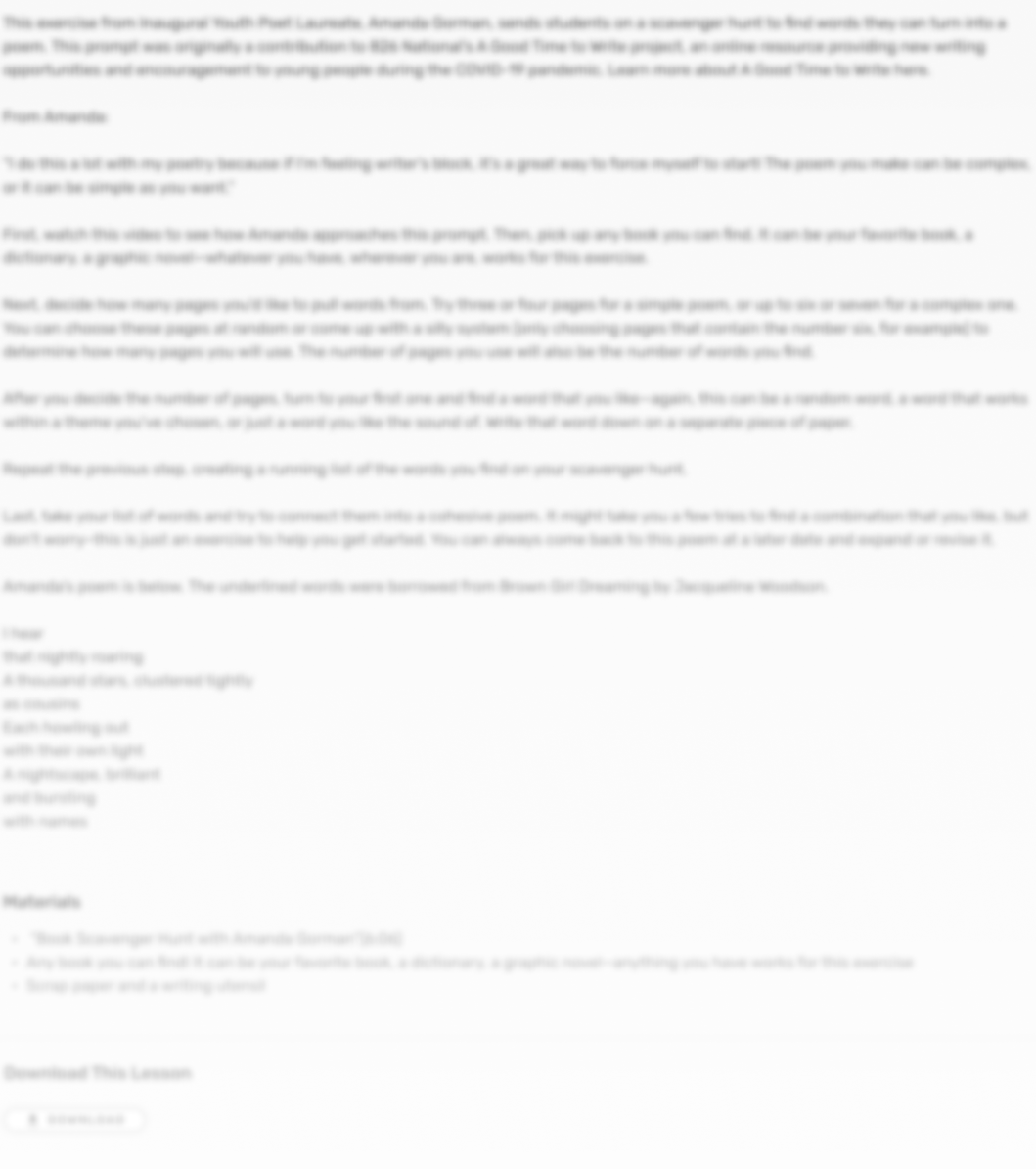 Grades 6–8
Grades 6–8 60+ Minutes
60+ Minutes Narrative, Poetry
Narrative, Poetry Videos
VideosCarter Higgins is a writer and illustrator of children’s books: her first book in both of these roles, Circle Under Berry, was named a Best Book of 2021 by Publisher’s Weekly, Smithosian Magazine, and The Wall Street Journal. Higgins is a visual storyteller who designs fun and playful literacy experiences for young readers and writers.
You will learn the difference between metaphors and similes, as well as a process to help them create their own metaphors.



Step 1
First, watch the video and read the mentor text in the Pick Up Lines Cheesier Than Cheddar with Carter Higgins—Handouts. In your writing journal, write down what you notice: What was your favorite part of this poem? What is the main subject that the poem compares to a chair, a backbone, and a typewriter?
Step 2
Next, you will brainstorm sensory adjectives that connect to the 5 senses. Metaphors compare two things, without using the words “like” or “as.” Metaphors rely on descriptive details and sensory language to connect and compare 2 things that might not seem like they have a lot in common. In your writing journal, write down the 5 senses (sight, sound, taste, touch/feeling, smell). Then, write an example of a sensory adjective that matches that sense. For example, your page could look like this:
Sight – colorful ...

by 826 National
In this lesson, you will build your confidence as a writer by battling the page on a consistent basis.
by Charlotte Yeung
Midwest Youth Poet Laureate Ambassador, Charlotte Yeung, shares one of her favorite brainstorming strategies for creating a new piece.
by 826 National
Writer and 826michigan staffer, Eli Sparkman, shares stories about some of his favorite personal objects and encourages students to write down their own.
by 826 National, featuring Nayeli Karunasekara, grade 6, Michigan
Through reading a Mentor Text, students learn more about the types of point of view and how different points of view impact their writing.
by Javier Zamora, 826 Valenica alumni and New York Times bestselling author
Author Javier Zamora invites you to raise your voice and write to the next President of the United States.
by Jason Reynolds
National Ambassador for Young People's Literature and NYT Bestselling Author, Jason Reynolds, joined 826 students for a conversation on his video project, "For Every One."
by 826 National
Award-winning documentarian and journalist,Soledad O'Brien, shares about why she loves her job and how she builds credibility out in the field through thorough research.
by 826 National
Author and illustrator Lisa Brown reads "Owl Girl. In this lesson, you will write a superhero story that introduces your character and establishes the context for your reader.
by Mychal Threets, librarian and literacy ambassador
Librarian and literacy ambassador Mychal Threets invites you to write about your feelings, your way with four writing prompts to explore your emotions on the page.
by 826 National, featuring Isaac Reynolds, Grade 6
What’s the moral of the story? In this lesson, students practice identifying and summarizing a moral in a fable written by a sixth grader.
by Mac Barnett
Mac Barnett, a New York Times-bestselling author of stories for children, illustrates how to end a story...or not.
by 826 National
In this lesson, you will learn a strategy for writing down your thoughts and feelings to understand them more clearly.
by 826 National
Author Tom Perrotta reads "Peter, Who Went on the Best Adventure Ever." In this lesson, you will learn about 3 shapes that will help the events of your story unfold naturally.
by Emily Harding
Author and TV producer, Emily Harding shows side characters some love in this writing prompt.
by Soeun Lee, Grade 8, Tenafly, New Jersey
In this poem, a student observes a dove's flight and reflects on their ability to soar.
by Amanda Gorman
Presidential Inaugural Poet, activist, and bestselling author Amanda Gorman shares one of her favorite techniques for starting a poem or getting over writers' block.
by 826 National
In this lesson, you will create a character and show how a character would respond in a specific situation by writing dialogue, resulting in a silly scene.
by Sarah Richman, 826DC
Writer and staffer at 826DC, Sarah Richman, shares an original writing prompt that will help you get aquainted with your new characters.
by 826 National, featuring Priyanna Kumar Singhania, Grade 8
In this lesson, you will write down a story that’s been passed down to you, using precise words and phrases and sensory language, to convey a vivid picture of the event.
by Amanda Dettmann, 826NYC
Poet and teaching artist with 826NYC, Amanda Dettmann, shares a simple and fun writing prompt that asks the question, "How Did You Get There?"
by 826 National, featuring Soeun Lee, Grade 8, NJ
In this lesson, you will create poems that look completely different from poems you have written before!
by Cristeta Boarini, 826 MSP
Journalist and 826 MSP staffer, Cristeta Boarini, shares a poetry prompt that walks students through using shapes to convey meaning.
by 826 National, featuring Eloise Combs, Grade 3, Michigan
Not all poems have to rhyme, but when they do, they generally use “rhyme scheme.” In this lesson, students will write a poem with a unique sound and rhyme scheme.
by 826 National, featuring Kaiden Griggs, Grade 6
In this lesson, students will identify the main idea and supporting details of an informational text and summarize this idea objectively.
by Daniel Handler
Author Daniel Handler, aka Lemony Snicket, shows there are no limits to imagination with this interviewing activity.


We are thrilled to have you as the newest member of our online community. Stay up-to-date on the the latest and most relevant resources, student publication opportunities, and what’s new with the 826 Digital community.
